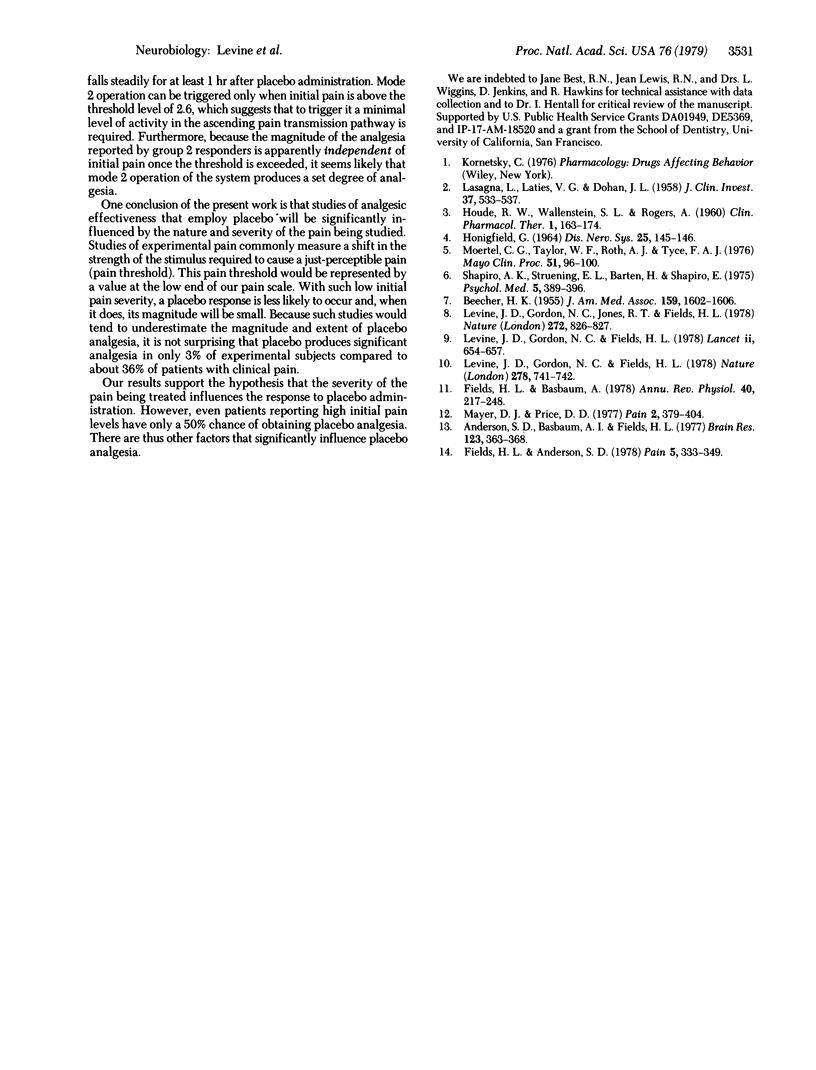Abstract
The hypothesis that perceived pain intensity can influence placebo analgesia was tested. One hundred and seven subjects rated their pain from from 0 to 10 on a visual analog scale after a standard wisdom tooth extraction. The expected course of such postoperative pain in the absence of therapy or placebo is a steady increase; this was confirmed by blind administration of the placebo. When placebos were given intravenously in view of the patients, some (placebo nonresponders) reported that their pain increased, whereas others (placebo responders) reported that their pain either decreased or remained the same over the next 60 min. A placebo response was more likely to occur if the pain rating 5 min prior to placebo administration (initial pain) was greater than 2.6. Furthermore, placebo responders with initial pain above this 2.6 level reported significantly greater mean analgesia than those with lower initial pain. Indeed, responders with initial pain less than 2.6 reported no change in pain during the 60 min after administration of a placebo. When their initial pain level was greater than 2.6, they reported a steady decline in pain over this period. However, above the 2.6 level there was no obvious relationship between the magnitude of the placebo analgesia and the initial pain.
Full text
PDF



Images in this article
Selected References
These references are in PubMed. This may not be the complete list of references from this article.
- Anderson S. D., Basbaum A. I., Fields H. L. Response of medullary raphe neurons to peripheral stimulation and to systemic opiates. Brain Res. 1977 Mar 11;123(2):363–368. doi: 10.1016/0006-8993(77)90487-5. [DOI] [PubMed] [Google Scholar]
- BEECHER H. K. The powerful placebo. J Am Med Assoc. 1955 Dec 24;159(17):1602–1606. doi: 10.1001/jama.1955.02960340022006. [DOI] [PubMed] [Google Scholar]
- Fields H. L., Anderson S. D. Evidence that raphe-spinal neurons mediate opiate and midbrain stimulation-produced analgesias. Pain. 1978 Dec;5(4):333–349. doi: 10.1016/0304-3959(78)90002-7. [DOI] [PubMed] [Google Scholar]
- Fields H. L., Basbaum A. I. Brainstem control of spinal pain-transmission neurons. Annu Rev Physiol. 1978;40:217–248. doi: 10.1146/annurev.ph.40.030178.001245. [DOI] [PubMed] [Google Scholar]
- HOUDE R. W., WALLENSTEIN S. L., ROGERS A. Clinical pharmacology of analgesics. 1. A method of assaying analgesic effect. Clin Pharmacol Ther. 1960 Mar-Apr;1:163–174. doi: 10.1002/cpt196012163. [DOI] [PubMed] [Google Scholar]
- LASAGNA L., LATIES V. G., DOHAN J. L. Further studies on the pharmacology of placebo administration. J Clin Invest. 1958 Apr;37(4):533–537. doi: 10.1172/JCI103635. [DOI] [PMC free article] [PubMed] [Google Scholar]
- Levine J. D., Gordon N. C., Fields H. L. Naloxone dose dependently produces analgesia and hyperalgesia in postoperative pain. Nature. 1979 Apr 19;278(5706):740–741. doi: 10.1038/278740a0. [DOI] [PubMed] [Google Scholar]
- Levine J. D., Gordon N. C., Fields H. L. The mechanism of placebo analgesia. Lancet. 1978 Sep 23;2(8091):654–657. doi: 10.1016/s0140-6736(78)92762-9. [DOI] [PubMed] [Google Scholar]
- Levine J. D., Gordon N. C., Jones R. T., Fields H. L. The narcotic antagonist naloxone enhances clinical pain. Nature. 1978 Apr 27;272(5656):826–827. doi: 10.1038/272826a0. [DOI] [PubMed] [Google Scholar]
- Mayer D. J., Price D. D. Central nervous system mechanisms of analgesia. Pain. 1976 Dec;2(4):379–404. doi: 10.1016/0304-3959(76)90080-4. [DOI] [PubMed] [Google Scholar]
- Moertel C. G., Taylor W. F., Roth A., Tyce F. A. Who responds to sugar pills? Mayo Clin Proc. 1976 Feb;51(2):96–100. [PubMed] [Google Scholar]
- Shapiro A. K., Struening E. L., Barten H., Shapiro E. Correlates of placebo reaction in an outpatient population. Psychol Med. 1975 Nov;5(4):389–396. doi: 10.1017/s0033291700057019. [DOI] [PubMed] [Google Scholar]



